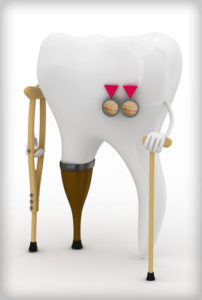Let’s Get Physical: A Breakdown of the Two Types of Physical Tooth Wear

A rough brush here, a heavy clench there. Tooth wear, a term that refers to the deterioration of tooth enamel. Can result from two different types of physical factors: attrition and abrasion.
A rough brush here, a heavy clench there—tooth wear, a term that refers to the deterioration of tooth enamel, can result from two different types of physical factors: attrition and abrasion. Although these types of tooth wear both result from physical factors, their causes are different. Are you noticing a change in tooth sensitivity or are seeing a change in your tooth’s enamel, but are unsure of the root cause? Dr. Jennifer Yue describes the topic of attrition and abrasion, so you can have a deeper understanding of your tooth wear issues.
Tooth-to-Tooth Contact and Attrition
Attrition is a type of tooth wear that can result from heavy biting, chewing, grinding or clenching. Although it’s considered to be a natural part of the aging process, it can happen to people of any age, especially those who have bruxism—a common condition in which a person habitually grinds their teeth or clenches their jaw.
Your Teeth, Objects and Abrasion
Abrasion is the second type of physical tooth wear. It is the result of certain objects that your teeth come in contact with. Common objects that can cause abrasion are:
- Toothbrushes
- Toothpicks
- Floss
- Retainers
- Dentures
While the dental objects are due to not fitting properly, toothbrushes—the most common culprit of abrasion—toothpicks and floss are typically the culprit when they are not used correctly. For example, if you’re brushing or flossing your teeth too aggressively, you may experience abrasion. Other reasons you may be experiencing abrasion? Biting your nails, chewing tobacco, smoking pipes, chewing on pencils or having a lip or tongue piercing can all also cause abrasion.
Physical Symptoms of Physical Tooth Wear
Attrition and abrasion may have very similar symptoms, however they can be caused by different things. These symptoms include, but are not limited to:
- A change in or loss of tooth anatomy
- Tooth or gum sensitivity and pain
- Tooth discoloration
- A change in your bite, or the way your teeth meet together
- Teeth positioned in a way that does not allow the jaw to move freely
If you are experiencing any of these symptoms, schedule an appointment with your dentist immediately.
Whether it’s been awhile since your last dental check up or you’re noticing significant changes in the condition of your tooth’s enamel since your last cleaning, Dr. Yue can help transform your teeth and your oral health. Contact Dr. Yue today!
Leave a Reply